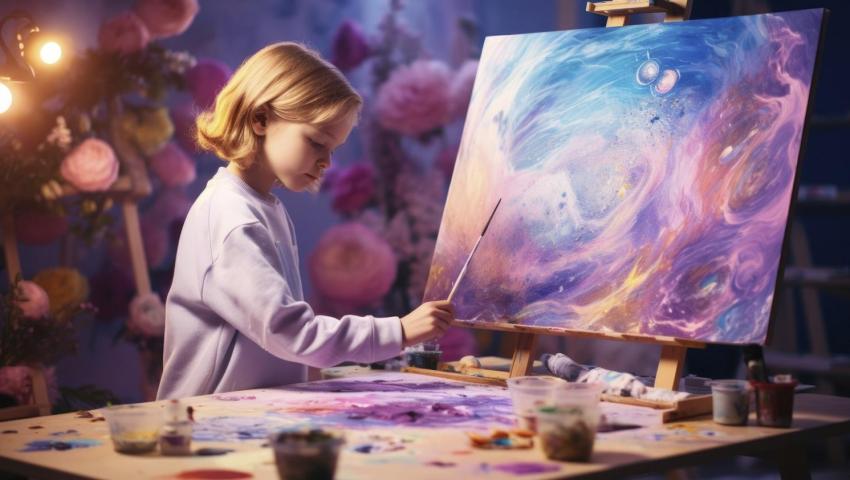
Art Therapy for Emotional Expression and Healing
Art Therapy is a powerful therapeutic approach that utilizes creative expression as a medium to explore emotions, manage psychological distress, and facilitate personal healing. This blog delves into the benefits, techniques, and applications of Art Therapy for individuals struggling with trauma, anxiety, depression, and emotional challenges.
Art Therapy is a unique, evidence-based form of psychotherapy that uses the creative process of art-making to improve an individual’s physical, mental, and emotional well-being. Rooted in the belief that the act of creating art can be inherently healing, Art Therapy provides a non-verbal outlet for individuals to express their feelings, process complex emotions, and explore their subconscious in ways that traditional talk therapy may not fully access.
This therapeutic approach is used to treat a wide array of psychological and emotional challenges, including trauma, depression, anxiety, grief, and emotional dysregulation. By tapping into the creative process, individuals can express difficult emotions, gain deeper insights into their inner worlds, and develop healthier ways to cope with stress.
Table of contents [Show]
The Foundations of Art Therapy
Art Therapy combines the principles of psychotherapy with the creative process to facilitate self-expression and emotional release. The primary goal of Art Therapy is not to create aesthetically pleasing art but to use the act of creation as a therapeutic tool. Through the use of different mediums—such as drawing, painting, sculpture, or collage—clients can communicate feelings and experiences that may be too difficult to articulate verbally.
The theoretical foundation of Art Therapy lies in psychoanalytic and humanistic theories, which emphasize the role of creativity in the healing process. Drawing from Jungian psychology, Art Therapy explores the connection between the unconscious mind and symbolic imagery, helping individuals process repressed emotions or unresolved trauma. Art Therapy also incorporates Gestalt principles, which focus on the individual’s experience in the present moment and encourage holistic healing.
Art Therapists are trained professionals who guide individuals through the art-making process, providing emotional support and therapeutic insight along the way. The therapist interprets the symbolic meaning of the artwork and facilitates discussions about the emotions, memories, and thoughts that emerge during the creative process. This collaborative relationship fosters self-awareness, emotional expression, and personal growth.
How Art Therapy Works: Techniques and Applications
Art Therapy can be adapted to meet the specific needs of different individuals, making it a versatile approach for both children and adults. Some of the most common techniques used in Art Therapy include:
- Free Drawing or Painting:
Individuals are encouraged to create spontaneous, unstructured drawings or paintings that reflect their inner emotional state. This technique allows for open-ended exploration of feelings and is particularly useful for clients who may struggle to express themselves verbally. - Mandala Creation:
A mandala is a circular, symmetrical design often used in spiritual practices to represent wholeness and balance. In Art Therapy, individuals create their own mandalas as a way to focus their attention, reduce anxiety, and gain a sense of inner harmony. The act of designing a mandala can promote mindfulness and help individuals process emotional turmoil. - Collage Making:
Collage is a technique in which individuals use images, photos, and other materials to create visual representations of their emotions or life experiences. This method can be particularly helpful for individuals who have difficulty with self-expression, as it allows them to visually piece together fragments of their emotions and memories. - Clay Sculpting:
Working with clay or other tactile materials provides a grounding, physical experience that helps individuals connect with their bodies and emotions. Sculpting allows for emotional release through the act of molding and shaping the material, often providing a cathartic experience for clients processing trauma or anger. - Symbolic Drawing or Painting:
In this technique, individuals are guided to create symbolic representations of their emotions, such as drawing their anxiety as a specific object or figure. This helps externalize and personify complex emotions, making them easier to understand and manage. - Guided Imagery and Visualization:
In some sessions, Art Therapists use guided imagery or meditation to help clients relax and access deeper layers of their subconscious. After the visualization, clients are encouraged to create artwork that reflects the emotions, symbols, or imagery that arose during the meditation. This technique is particularly effective for trauma recovery and emotional healing.
The Healing Benefits of Art Therapy
Art Therapy offers a wide range of emotional, psychological, and physical benefits. Some of the key therapeutic benefits include:
- Emotional Expression:
Many individuals struggle to articulate their emotions, especially when dealing with trauma, grief, or deep-seated emotional pain. Art Therapy provides a non-verbal outlet for emotional expression, allowing clients to communicate their feelings through color, texture, and form. This can be particularly beneficial for individuals who have experienced trauma, as art offers a safe space to express emotions that may feel too overwhelming to verbalize. - Stress Reduction and Relaxation:
Engaging in creative activities has been shown to reduce cortisol levels, the hormone associated with stress. Art-making promotes relaxation, mindfulness, and emotional regulation, helping individuals manage anxiety, depression, and everyday stressors. The focus required to create art can also induce a meditative state, allowing individuals to quiet their minds and focus on the present moment. - Trauma Processing:
Art Therapy is a powerful tool for trauma recovery. Trauma often resides in the body and the subconscious, making it difficult to process through words alone. Through the creation of art, individuals can access and process traumatic memories in a safe, contained way. Art Therapy can help trauma survivors externalize their experiences, create a sense of distance from the trauma, and reframe painful memories in a more manageable way. - Increased Self-Awareness:
Creating art can lead to greater self-awareness, as it encourages individuals to explore their thoughts, emotions, and behaviors in a new light. Through reflective discussions with the therapist, clients can gain insights into their emotional patterns, uncover subconscious beliefs, and develop a deeper understanding of themselves. This increased self-awareness can lead to greater emotional intelligence and healthier coping mechanisms. - Improved Mental Health:
Art Therapy has been shown to reduce symptoms of anxiety, depression, and PTSD. By engaging in the creative process, individuals can redirect negative thoughts and emotions, find relief from emotional distress, and develop a sense of mastery and control over their lives. Art Therapy also fosters a sense of accomplishment and self-esteem, as clients see tangible progress in their art-making process and emotional healing. - Building Resilience:
Art Therapy promotes emotional resilience by helping individuals navigate difficult emotions, cope with challenges, and foster a sense of hope and empowerment. Through the process of creating and reflecting on their art, clients can identify their strengths, process difficult experiences, and develop new ways of handling adversity.
Who Can Benefit from Art Therapy?
Art Therapy is a flexible and adaptable approach that can benefit a wide range of individuals, including:
- Children:
Children often struggle to articulate their emotions verbally, making Art Therapy an ideal way for them to express feelings and process difficult experiences. Art Therapy is commonly used with children who have experienced trauma, bullying, or family conflict, and it helps them develop healthy emotional expression and coping skills. - Trauma Survivors:
Art Therapy is highly effective for individuals recovering from trauma, including survivors of abuse, violence, and war. The non-verbal nature of Art Therapy allows trauma survivors to process their experiences in a safe, non-threatening way, without the need to relive their trauma through words. - Individuals with Anxiety or Depression:
Art Therapy can help individuals manage symptoms of anxiety and depression by providing a creative outlet for emotional release, promoting relaxation, and improving self-esteem. Engaging in the art-making process can help individuals shift their focus away from negative thoughts and build emotional resilience. - Seniors:
Art Therapy is also beneficial for older adults, particularly those dealing with cognitive decline, loneliness, or grief. Creating art stimulates cognitive function, improves mood, and fosters a sense of purpose and connection.
Conclusion: Art Therapy as a Path to Healing
Art Therapy is a transformative and versatile therapeutic approach that offers individuals a unique way to explore and heal their emotional worlds. By engaging in the creative process, individuals can express emotions that may be difficult to verbalize, gain new insights into their personal experiences, and develop healthier coping mechanisms for emotional challenges. Whether used in conjunction with traditional talk therapy or as a standalone treatment, Art Therapy has the power to unlock emotional healing, promote self-awareness, and foster resilience.



